Discover Florida Nature
It's time to explore the natural Florida


|
|
|
|
|
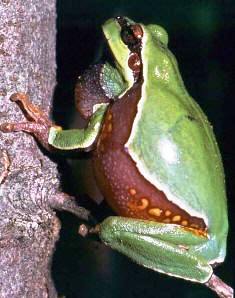 Pine
Barrens Treefrog- In Florida, the Pine Barrens treefrog is
found only in hillside seepage bogs in Santa Rosa, Okaloosa and Walton
counties of the western panhandle. The pine barrens treefrog in Florida
reaches 1.25-1.50 inches in length. However, the pine barrens treefrog
in the Carolinas and New Jersey may be slightly larger. The pine barrens
treefrog has a bright green back with a brownish stripe running through
the eye and down the side. The stripe is bordered by white or yellow.
Additionally, there are yellow spots on the underside of the legs. Males
call with a rapid "quank-quank-quank" on wet nights from March to
September. The pine barrens treefrog is
protected in Florida, due to its low population numbers and the
destruction of its habitat. Pine
Barrens Treefrog- In Florida, the Pine Barrens treefrog is
found only in hillside seepage bogs in Santa Rosa, Okaloosa and Walton
counties of the western panhandle. The pine barrens treefrog in Florida
reaches 1.25-1.50 inches in length. However, the pine barrens treefrog
in the Carolinas and New Jersey may be slightly larger. The pine barrens
treefrog has a bright green back with a brownish stripe running through
the eye and down the side. The stripe is bordered by white or yellow.
Additionally, there are yellow spots on the underside of the legs. Males
call with a rapid "quank-quank-quank" on wet nights from March to
September. The pine barrens treefrog is
protected in Florida, due to its low population numbers and the
destruction of its habitat.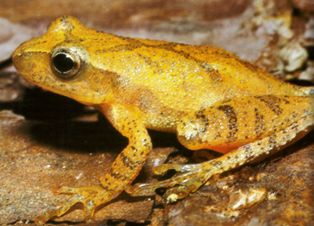 Southern
Spring Peeper- The spring peeper is one of the most familiar
frogs in the eastern United States. Chorus frogs are most often heard
and not seen. This frog can be recognized, however by its tan, brown, or
grayish body with a distinctive dark X on its back. The Spring Peeper
occurs in Florida in hardwood bottoms from the vicinity of Orlando
northwards. The spring peeper is a chorus frog, and the habitats of
chorus frogs usually include shallow, and often temporary, bodies of
water, or areas where they may remain well hidden, such as clumps of
grass or other vegetation. It is found in wooded areas and in or near
ponds and swamps that are temporarily or permanently flooded. Spring
peepers are nocturnal, and they hibernate during the day under logs or
loosened bark on trees. The Spring Peeper will sing during both the day
and the night, his song sounds like a rising whistle, or a series of
high-pitched whistles and trills. Southern
Spring Peeper- The spring peeper is one of the most familiar
frogs in the eastern United States. Chorus frogs are most often heard
and not seen. This frog can be recognized, however by its tan, brown, or
grayish body with a distinctive dark X on its back. The Spring Peeper
occurs in Florida in hardwood bottoms from the vicinity of Orlando
northwards. The spring peeper is a chorus frog, and the habitats of
chorus frogs usually include shallow, and often temporary, bodies of
water, or areas where they may remain well hidden, such as clumps of
grass or other vegetation. It is found in wooded areas and in or near
ponds and swamps that are temporarily or permanently flooded. Spring
peepers are nocturnal, and they hibernate during the day under logs or
loosened bark on trees. The Spring Peeper will sing during both the day
and the night, his song sounds like a rising whistle, or a series of
high-pitched whistles and trills.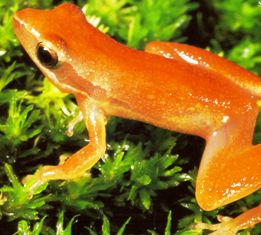 Little
Grass Frog- The Little Glass Frog's characteristic marking is a
dark line passing through its eye and extending down the length of its
body. The length of this line may be variable, but it is always present.
Generally, its coloring is tan, brown, green, reddish or pink, with a
dark, narrow stripe separating its body color from the lighter coloring
of its sides. Another dark, narrow stripe may extend from a
triangle-shaped spot between the eyes to the end of this frogs body.
The habitat of the little grass frog includes grassy ponds, marshes, and
shallow, often temporary, bodies of water. It is usually in clumps of
grass where it is well hidden. The little grass frog is the smallest of
all North American frogs, ranging is length from 7/16 to 5/8 of an inch.
The little grass frog's call is described as a tinkling sound or a
high-pitched chirp, similar to the call of insects such as a tree
cricket. It may be heard throughout most of the year. They also sing
during both the day and the night. Little
Grass Frog- The Little Glass Frog's characteristic marking is a
dark line passing through its eye and extending down the length of its
body. The length of this line may be variable, but it is always present.
Generally, its coloring is tan, brown, green, reddish or pink, with a
dark, narrow stripe separating its body color from the lighter coloring
of its sides. Another dark, narrow stripe may extend from a
triangle-shaped spot between the eyes to the end of this frogs body.
The habitat of the little grass frog includes grassy ponds, marshes, and
shallow, often temporary, bodies of water. It is usually in clumps of
grass where it is well hidden. The little grass frog is the smallest of
all North American frogs, ranging is length from 7/16 to 5/8 of an inch.
The little grass frog's call is described as a tinkling sound or a
high-pitched chirp, similar to the call of insects such as a tree
cricket. It may be heard throughout most of the year. They also sing
during both the day and the night.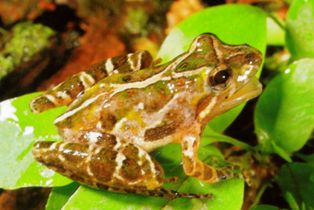 Florida
Cricket Frog- This frog varies in color from dark brown to tan
or green. Cricket Frogs are easily identifiable by a triangular mark
just behind the head and between the eyes. A distinct stripe is often,
but not always, present along its spine. There are three types of
Cricket Frogs in Florida: Northern Cricket Frog, Southern Cricket Frog,
and Florida Cricket Frog. The Florida Cricket Frog has two dark stripes
on the rear hidden surface of its thigh and does not have anal warts.
Cricket frogs have webbed toes, unlike chorus frogs, do not have
enlarged toe pads, like tree frogs, and do not have enlarged glands
behind the head, like small toads. Cricket Frogs are found throughout
state except in the extreme northwestern panhandle. It can be found in
freshwater environments such as temporary puddles, marshes, lakes,
streams and roadside ditches. The call of the Florida Cricket Frog is a
rapid "click-click-click", similar to the sound of two glass marbles
being knocked against each other. Florida
Cricket Frog- This frog varies in color from dark brown to tan
or green. Cricket Frogs are easily identifiable by a triangular mark
just behind the head and between the eyes. A distinct stripe is often,
but not always, present along its spine. There are three types of
Cricket Frogs in Florida: Northern Cricket Frog, Southern Cricket Frog,
and Florida Cricket Frog. The Florida Cricket Frog has two dark stripes
on the rear hidden surface of its thigh and does not have anal warts.
Cricket frogs have webbed toes, unlike chorus frogs, do not have
enlarged toe pads, like tree frogs, and do not have enlarged glands
behind the head, like small toads. Cricket Frogs are found throughout
state except in the extreme northwestern panhandle. It can be found in
freshwater environments such as temporary puddles, marshes, lakes,
streams and roadside ditches. The call of the Florida Cricket Frog is a
rapid "click-click-click", similar to the sound of two glass marbles
being knocked against each other.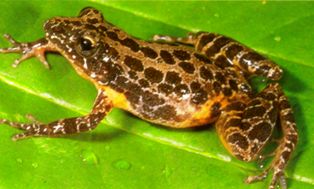 Florida
Chorus Frog- The Florida chorus frog was, and may still be, a
common frog in Florida. Why don't we know for sure if it is still
common? This frog's secretive nature makes it difficult to accurately
measure its population numbers. In terms of range, this frog can be
found in most of the peninsula, south of a line roughly from
Cedar Key
to Jacksonville. When calling, this tiny frog is usually hidden at the
base of grass clumps at or near the edge of water -- with only its head
above the water surface. These seldom-seen frogs inhabit flooded fields,
wet marshes, drainage ditches, pine woodland ponds, and other similarly
open habitats. They also inhabit ponds in woodlands that have dense
understory vegetation. The Florida chorus frog reaches a maximum length
of 1.25 inches and can vary greatly in color and intensity of pattern.
If cold, they can be a dark charcoal color with the spots barely
noticeable. When warm, the same frog can be light grey with bold
charcoal-grey spots. The breeding of Florida chorus frogs is determined
by the occurrence of rain. Winter rains in northern Florida allow for
winter and early spring breeding, while the rainy season in southern
Florida occurs from spring to autumn. The call of the Florida chorus
frog is similar to the sound of a fingernail drawn over the teeth of a
pocket comb. The speed of the call, or trill rate, varies with air
temperature (faster when warm, slower when cold). Florida
Chorus Frog- The Florida chorus frog was, and may still be, a
common frog in Florida. Why don't we know for sure if it is still
common? This frog's secretive nature makes it difficult to accurately
measure its population numbers. In terms of range, this frog can be
found in most of the peninsula, south of a line roughly from
Cedar Key
to Jacksonville. When calling, this tiny frog is usually hidden at the
base of grass clumps at or near the edge of water -- with only its head
above the water surface. These seldom-seen frogs inhabit flooded fields,
wet marshes, drainage ditches, pine woodland ponds, and other similarly
open habitats. They also inhabit ponds in woodlands that have dense
understory vegetation. The Florida chorus frog reaches a maximum length
of 1.25 inches and can vary greatly in color and intensity of pattern.
If cold, they can be a dark charcoal color with the spots barely
noticeable. When warm, the same frog can be light grey with bold
charcoal-grey spots. The breeding of Florida chorus frogs is determined
by the occurrence of rain. Winter rains in northern Florida allow for
winter and early spring breeding, while the rainy season in southern
Florida occurs from spring to autumn. The call of the Florida chorus
frog is similar to the sound of a fingernail drawn over the teeth of a
pocket comb. The speed of the call, or trill rate, varies with air
temperature (faster when warm, slower when cold).
|
|
|
Advertise | Privacy Statement | Dog Encyclopedia | Video |Contact | Alaska Nature |
|